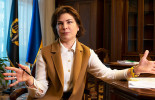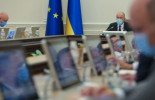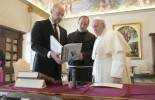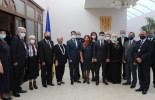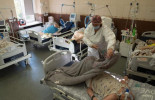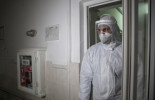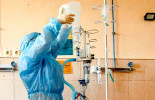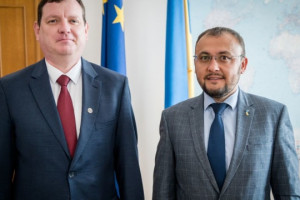 Ukraine reports 5,276 new COVID-19 cases
Ukraine reports 5,276 new COVID-19 cases
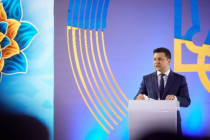 Zelensky: Every third Ukrainian considers road construction one of greatest achievements of 2021
Zelensky: Every third Ukrainian considers road construction one of greatest achievements of 2021
 Ukraine ready to implement Minsk agreements, but Russia's desire needed - Yermak
Ukraine ready to implement Minsk agreements, but Russia's desire needed - Yermak
 Michel: EU unanimously agree to roll over economic sanctions against Russia
Michel: EU unanimously agree to roll over economic sanctions against Russia
 Actions by Ukraine's partners will help prevent worst-case scenario - Zelensky
Actions by Ukraine's partners will help prevent worst-case scenario - Zelensky
 COVID-19 in Ukraine: Health officials confirm 8,899 daily cases as of Dec 17
COVID-19 in Ukraine: Health officials confirm 8,899 daily cases as of Dec 17
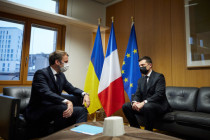 Macron tells Zelensky he declared support for Ukraine in call with Putin
Macron tells Zelensky he declared support for Ukraine in call with Putin
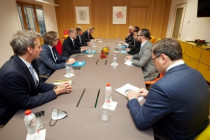 Zelensky, Scholz discuss gas transit through Ukraine after 2024
Zelensky, Scholz discuss gas transit through Ukraine after 2024
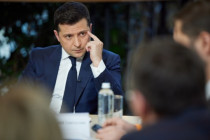 Ukraine ready for any format of talks with Russia - Zelensky
Ukraine ready for any format of talks with Russia - Zelensky
 Ukraine’s only journalist in Russia facing extremism charges - lawyer
Ukraine’s only journalist in Russia facing extremism charges - lawyer
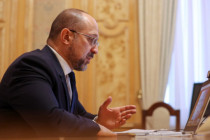 PM Shmyhal: First two applications for investment projects worth $96 million filed
PM Shmyhal: First two applications for investment projects worth $96 million filed
 Zelensky, PM of Italy discuss security situation around Ukraine
Zelensky, PM of Italy discuss security situation around Ukraine
 President signs off State Budget 2022
President signs off State Budget 2022
 London considering all options for responding to Russia's aggression against Ukraine
London considering all options for responding to Russia's aggression against Ukraine
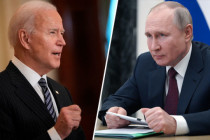 Putin, Biden to hold another round of talks
Putin, Biden to hold another round of talks
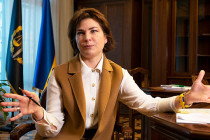 Some 260,000 Ukrainians “victims of human trafficking” over 30 years - prosecutor general
Some 260,000 Ukrainians “victims of human trafficking” over 30 years - prosecutor general
 Ukraine plans to create center to protect energy infrastructure from cyber attacks
Ukraine plans to create center to protect energy infrastructure from cyber attacks
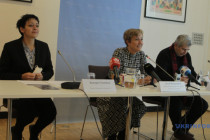 No clear idea so far when Normandy Four top diplomats set to meet - German Ambassador
No clear idea so far when Normandy Four top diplomats set to meet - German Ambassador
 Ukraine receives EUR 600M in macro-financial assistance from EU
Ukraine receives EUR 600M in macro-financial assistance from EU
 Zelensky holds phone conversation with PM of Israel
Zelensky holds phone conversation with PM of Israel
 Ukraine sets new daily COVID vaccination record
Ukraine sets new daily COVID vaccination record
 MFA: European Union has not yet removed Ukraine from list of safe countries
MFA: European Union has not yet removed Ukraine from list of safe countries
 Kyiv records 1,023 new COVID-19 cases, 29 deaths
Kyiv records 1,023 new COVID-19 cases, 29 deaths
 G7 ambassadors welcome adoption of law on NABU status
G7 ambassadors welcome adoption of law on NABU status
 Ukraine can increase Covid vaccination rates to 1.5M a week – Liashko
Ukraine can increase Covid vaccination rates to 1.5M a week – Liashko
A half-deflated leather football, a box of marbles, a ragged doll and a handful of windup cars and trains line the display cabinets in the Evita Museum like ancient relics. These worn-out toys played a vital role in the rise of Peronism in Argentina, one of the most influential movements in Latin America.
Long before politicians started using social media to influence public opinion, the political movement of Juan Perón and his second wife also sought to touch voters on a personal level: handing out toys to 4 million children from Argentina’s poorest families. The practice was fundamental to the popularity and at times unconditional backing showered by Argentines on Peronism, which persisted far beyond the deaths of Perón and wife Eva María Duarte, famously known as Evita and idolized by her supporters as the “champion of the poor.”
To mark the 100th anniversary of her birth on May 7, 1919, the Evita Museum in Buenos Aires has inaugurated an exhibition titled “Childhood and Peronism, the toys of the Eva Perón Foundation.” It displays several dozen of the toys distributed by the party every Christmas Day and the Epiphany holiday between 1948 and 1955.
“Children were always given particular importance in Eva’s work, especially all matters concerning children’s rights,” Marcela Genés, the museum’s curator, told The Associated Press. “She herself had a very impoverished childhood and that stayed with her. Achieving justice for children was a particular focus for Eva.”
Juan Perón, an army general, served as president for two different spans. He first took office in 1946 and won re-election in 1951 with a landslide victory of 63.4% of the votes, still the highest percentage ever in Argentina. The beginning of his second term, in 1952, was overshadowed by Evita’s death at age 33 from uterine cancer. Three years later, he was overthrown and forced into exile by a military coup. After 18 years, Perón returned and was elected president again in 1973. He served until his death in 1974 and was succeeded by his widow, Isabel Perón, who herself was ousted by the military in 1976.
Leaving behind humble beginnings, Evita arrived in Buenos Aires as a teenager. She worked as an actress until she met Perón at a festival held to raise funds for the victims of Argentina’s 1944 earthquake. Once she had become first lady, she created the Eva Perón Foundation after being prevented from heading the Buenos Aires Charitable Society, an organization formed by upper-class women who traditionally appointed the first lady as its honorary president.
Many children were delivered toys by Evita herself, while others picked up their gifts at post offices across the country.
One item in the museum exhibit is a tin train set. Somewhat rusty, it has huge sentimental value for 80-year-old Saúl Macyszyn. Seven decades ago, it helped him recover after an accident left him without one arm and paralyzed in the other arm and both legs.
Macyszyn chokes up when he recalls being visited in the hospital by Evita after undergoing a seventh surgery.
“I saw many doctors and nurses coming toward me. Evita was in the middle of them. With all the flashes from the photographers’ cameras, it looked like she had fallen from heaven,” he said.
First, Evita greeted his parents. She then approached his bedside and said: “Look, little Saúl, you will not be able to be a worker like your father. You will have to study. The foundation will give you a scholarship.”
Macyszyn said the accident had left him isolated, because an amputated arm was considered “monstrous” in those days. The train set he received from Evita served as a bridge with other children.
Saúl Macyszyn's tin toy trains are displayed at the "Childhood and Peronism, the toys of the Eva Perón Foundation" exhibit. (AP Photo/Natacha Pisarenko)
“Everyone in the neighborhood would come, so I had lots of friends. I had a happy childhood,” he said.
The foundation continued after Evita’s death until the coup toppled Perón.
Critics of Peronism accuse the movement of engaging in populism and patronage to win votes from the poor rather than promoting social mobility through enduring structural reforms. But away from political debates, Evita’s persona has transcended time and borders.
The worldwide fascination began in the 1970s with Andrew Lloyd Webber’s musical “Evita.” Then came Alan Parker’s film starring Madonna that was based on the musical, followed by Evita’s dresses shown at New York’s Metropolitan Museum of Art as part of a Christian Dior exhibit. The Evita Museum draws dozens of tourists every day.
One recent visitor, Paola Jaque of Chile, looked at the toy exhibition in admiration.
“The variety of toys and the letters the children wrote to ask her for toys caught my eye,” Jaque said. “She answered them personally, which I don’t believe happens nowadays.”










































